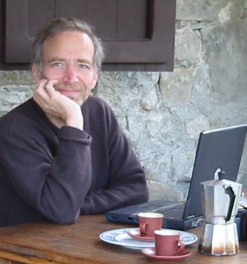
One day in May, our old friend Susan—a retired professor of social psychology and college administrator, now a full-time activist—British-born, elegant and pretty—took us on a tour of some places in the West Bank that few Israelis ever see.
Susan is a member—and has been for many years—of MachsomWatch, an organization of Jewish women in Israel, originally mainly grandmothers, who began hanging out at checkpoints at the borders of and within the Palestinian territories. Since 2001, as the Second Intifada led to an expansion of the network of checkpoints, they have kept up these visits, each going once a week or so with one or more other members, and they do what their name says: Watch.
And they talk to the young soldiers, often very young, in something like the way a grandma (bubbe in Yiddish, safta in Hebrew) might—if a grandchild she cared about was doing something that seemed wrong. I spent a long morning with Susan and one of her colleagues at a checkpoint near Tulkarm in 2004. Hundreds of Palestinians were lined up in the hot sun to have their bags and i.d.s checked by IDF soldiers.
Slowly, very slowly, they moved through the line. If one of the MachsomWatch women saw a soldier speaking harshly to someone or holding them up in a way that seemed gratuitous, they would go over and ask why. Occasionally a young man was set aside to sit and wait under a currogated plastic roof. By the end of the morning there were three or four of them. The Machsom Watchers asked about them too.
But it seemed to me the main thing they did was to bear witness—stand there and, as their name says, watch—to make it less likely that a young soldier, frustrated, worn down by the task and the thickening heat of the day, would do something harmful or just humiliating, beyond what had become routine, necessary or not. Something that the soldier or even the State of Israel might later regret.
Susan said I could take pictures, and I did, then and now. Nothing out of the ordinary happened that day or this—just the usual humbling of people going to work or school, visiting relatives, or trying to tend their olive orchards or agricultural land. Just the usual interference with everyday life.

But Susan had another purpose that she describes with passion and backs up with her life: to show the Palestinians a different Israeli face from the one they almost always see and have learned to fear and hate, and ultimately to adapt to, for what they see as a limited time.
Susan uses the word “sumud,” Arabic for patience or steadfastness, although from the way she uses it its deeper meaning must be something like forbearance. The Crusaders, after all, were in the Levant for two centuries, but the desert swallowed many of them and Sala’adin’s Arab armies drove the rest away. Sumud, the harsh landscape almost seems to say. Not even the first century of Jewish rule has run its course.
In 2004 Susan had not been doing this for very long, but she was very good at it, and it evolved into a life devoted to opposing the occupation, to observing systematically in many different ways, to raising grant money to keep her work and that of others—including those, like many Palestinians, who would not be able to raise that money on their own behalf, but who are working, peacefully, to set some limit on their own unjust experience.
So Ann and I asked Susan to take us both along on one of her weekly expeditions in 2011—seven years of occupation later. Susan’s official report (with which I am supplementing my notes and my memory) gave us the honor of including us: “Ann K.” and “Mel K.” And she named her colleague, “Alix W.” Both of them have done this work for many years now.
We arrived at the appointed place in Israel proper and got into Susan’s car. As she drove, she gave Ann the basic narrative of the occupation: 44 years now of domination punctuated by violence, a relentless appropriation of Palestinian land for Jewish settlements, and since the Second Intifada this network of checkpoints around and within the territories. Finally, beginning in 2006, the separation fence and wall went up, often within what was supposed to become Palestine, appropriating still more land for Israeli security and convenience.
Driving east, we crossed the Green Line, the place where Israel ended before ‘67, and a little while later we saw the separation fence.
More on this visit next time.
